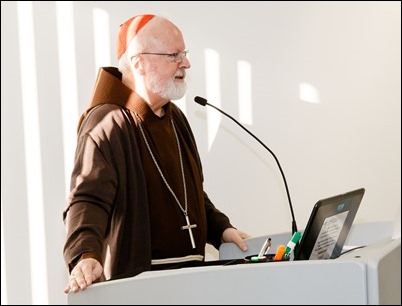
On Thursday and Friday of last week, Cardinal Seán O’Malley of Boston hosted a meeting of Massachusetts religious leaders and climate scientists to explore the possibility of taking joint action to address the challenge of climate change in the Bay State.
Full disclosure: I helped organize the thing.
Last summer I happened to be discussing religion and climate change with Philip Duffy, head of the Woods Hole Research Center, internationally acclaimed as the world’s leading climate research lab. Duffy, who oversaw climate policy in the Obama White House, suggested getting such a coalition together. I agreed to lend a hand.
At a time when the national government is headed by an Administration determined to undermine existing policies to mitigate climate change, action at the subnational level—state and local—looks to be the only way forward. Where better to start than in Massachusetts, with its concentration of scientists and a faith community whose most prominent member is the North American prelate closest to Pope Francis, author of a clarion call to action on climate change?
The meeting, which took place at the Archdiocese of Boston’s Pastoral Center, included religious leaders from a wide spectrum of religious traditions. “We can do the science,” Duffy told them. “We need to summon the political will.”
“The time is ripe for a new initiative,” declared Rev. Margaret Bullitt-Jonas, an Episcopal priest who works full time on climate issues for both the Episcopal Church and the United Church of Christ. (Over the weekend, Bullitt-Jonas blogged a fine account of what transpired.)
It’s worth recalling that nearly three decades ago, 33 of America’s most distinguished scientists—including Carl Sagan, Stephen Jay Gould, Edward O. Wilson, and Hans Bethe—appealed to religion to work with science on environmental issues. At a meeting in Moscow in the bright glow of the end of Cold War, they issued a statement that read in part:
As scientists, many of us have had profound experiences of awe and reverence before the universe. We understand that what is regarded as sacred is more likely to be treated with care and respect. Our planetary home should be so regarded. Efforts to safeguard and cherish the environment need to be infused with a vision of the sacred. At the same time, a much wider and deeper understanding of science and technology is needed. If we do not understand the problem, it is unlikely we will be able to fix it. Thus, there is a vital role for religion and science.
The following year, 271 religious leaders from around the world organized by Notre Dame President Theodore Hesburg and Elie Wiesel replied in kind:
We are moved by the Appeal’s spirit and challenged by its substance. We share its sense of urgency. This invitation to collaboration marks a unique moment and opportunity in the relationship of science and religion.
The hoped-for collaboration never took place. The result instead was the National Religious Partnership for the Environment—an interfaith organization.
As O’Malley put it in his own blog post on the meeting, “While there have been scientific advisers to religious organizations, and scientists who seek religious inspiration, this would be a unique coalition with the goal of bringing the combined intellectual and moral authority of both groups to the task of caring for our planet.”
Stay tuned.






